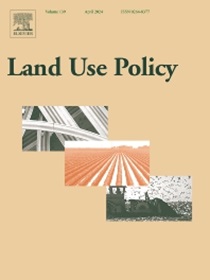济南的地方依恋与城市规划之间的关系:在发展中国家,环境质量会影响人的感知吗?
IF 6
1区 社会学
Q1 ENVIRONMENTAL STUDIES
引用次数: 0
摘要
人的感知是地方依恋的重要组成部分,但它对以人为本的城市规划的贡献仍不明确。全球变化极大地改变了人们的生活方式,在线 "社交 "领域的参与度激增。社交媒体作为个人表达观点的主要渠道,已经崭露头角。然而,目前的研究缺乏对使用社交媒体将城市环境与人们的看法联系起来的整体考虑。此外,复杂的社交媒体数据处理也是一个技术难题。本研究创新性地使用了基于深度学习的 BERT 技术来分析来自社交媒体的在线数据,并将人的感知细分为 9 种情绪和 10 种行为。在斯皮尔曼相关、地理加权回归(GWR)和多层次多叉逻辑回归的基础上,研究了城市建筑环境质量和个体差异对居民感知的影响。结果表明,城市设施密度越大,城市用地越多样化,居民越容易表达积极情绪,活动类型也越多。女性和老年人更容易产生地方依恋。我们的研究从理论和实证两个角度探讨了环境质量对人类感知的影响,并对人地关系有了更深入的理解。考虑地方依恋的城市规划可以为城市的可持续发展创造机会,并提高人类的生活质量。本文章由计算机程序翻译,如有差异,请以英文原文为准。
Between place attachment and urban planning in Jinan: Does environmental quality affect human perception in a developing country context?
Human perception is a critical component of place attachment, but its contribution to people-oriented urban planning remains unclear. Global shifts have dramatically transformed the way people live, with a surge in engagement in online “social” spheres. Social media has risen to prominence as the principal conduit through which individuals articulate their views. However, current research lacks an overall consideration of the use of social media to link the urban environment with people’s perceptions. Furthermore, complex social media data processing presents another technical difficulty. This study presents an innovative use of deep learning BERT-based techniques to analyze online data from social media and subdivide human perceptions into 9 emotions and 10 behaviors. On the basis of Spearman correlation, geographically weighted regression (GWR), and multilevel multinomial logistic regression, we investigate the impact of the quality of the urban built environment and individual differences on residents’ perceptions. The results show that the greater the density of urban amenities and the more diverse urban land uses are, the more likely residents are to express positive emotions and the greater the number of types of activity. Women and older people are more likely to develop place attachment. Our research explores the impact of environmental quality on human perception from both theoretical and empirical perspectives and provides a deeper understanding of the human![]() land relationship. Urban planning that considers place attachment can create opportunities for sustainable urban development and improve the quality of human life.
land relationship. Urban planning that considers place attachment can create opportunities for sustainable urban development and improve the quality of human life.
求助全文
通过发布文献求助,成功后即可免费获取论文全文。
去求助
来源期刊

Land Use Policy
ENVIRONMENTAL STUDIES-
CiteScore
13.70
自引率
8.50%
发文量
553
期刊介绍:
Land Use Policy is an international and interdisciplinary journal concerned with the social, economic, political, legal, physical and planning aspects of urban and rural land use.
Land Use Policy examines issues in geography, agriculture, forestry, irrigation, environmental conservation, housing, urban development and transport in both developed and developing countries through major refereed articles and shorter viewpoint pieces.
 求助内容:
求助内容: 应助结果提醒方式:
应助结果提醒方式:


